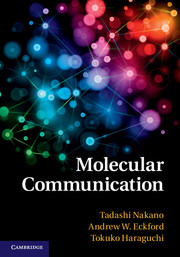Book contents
- Frontmatter
- Contents
- Preface
- 1 Introduction
- 2 Nature-made biological nanomachines
- 3 Molecular communication in biological systems
- 4 Molecular communication paradigm
- 5 Mathematical modeling and simulation
- 6 Communication and information theory of molecular communication
- 7 Design and engineering of molecular communication systems
- 8 Application areas of molecular communication
- 9 Conclusion
- Appendix Review of probability theory
- Index
- References
5 - Mathematical modeling and simulation
Published online by Cambridge University Press: 05 September 2013
- Frontmatter
- Contents
- Preface
- 1 Introduction
- 2 Nature-made biological nanomachines
- 3 Molecular communication in biological systems
- 4 Molecular communication paradigm
- 5 Mathematical modeling and simulation
- 6 Communication and information theory of molecular communication
- 7 Design and engineering of molecular communication systems
- 8 Application areas of molecular communication
- 9 Conclusion
- Appendix Review of probability theory
- Index
- References
Summary
In this chapter, we are concerned with mathematical models for molecular communication systems, which allow engineers to perform mathematical analysis, design, and optimization on communication systems. Furthermore, the system model also provides a level of mathematical abstraction, which allows a communication system engineer to understand a molecular communication system along with the biochemical background provided elsewhere in this book. As a result, tools from the vast literature on communications systems may be adapted to molecular communication.
In this chapter, we review recent results in channel modeling for molecular communication. These, and related, models are used in Chapter 6 to calculate the channel capacity of molecular communication, but we present brief examples to introduce the communication problem. This chapter requires familiarity with basic probability and the Gaussian distribution; for a brief review, see Appendix.
Discrete diffusion and Brownian motion
Free molecules in a fluid propagate via Brownian motion, i.e., the random motion induced by collisions with the fluid's molecules. Although highly random, Brownian motion is always available, and has the advantage of zero energy cost to the user. Furthermore, Brownian motion is a very well studied phenomenon, with a rich mathematical literature. In this section, we exploit that literature to derive mathematical models for Brownian motion.
- Type
- Chapter
- Information
- Molecular Communication , pp. 71 - 96Publisher: Cambridge University PressPrint publication year: 2013

